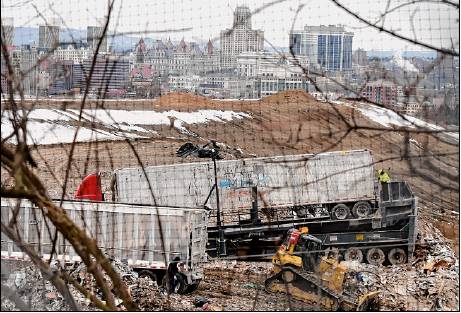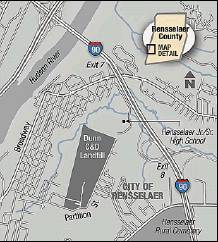Dump fight coming to school
Opponents of Rensselaer landfill to bring concerns to city board of education
By Brian Nearing
Rensselaer
Opponents of the state’s largest construction and demolition debris dump are taking their case to the Rensselaer City School District, which has its junior-senior high school in the shadow of the dump.
Fliers appeared last week in city neighborhoods urging residents with concerns over the 99-acre S.A. Dunn landfill, located off Partition Street, to attend the 6:30 p.m. Wednesday meeting of the school board at the campus on Van Rensselaer Drive.
“We want to have residents meet with the board to air their concerns,” said Christine Kielb, a member of the grassroots group Stop Trucks from Assaulting Rensselaer, which is promoting the meeting along with another group, Rensselaer Residents Against Toxic Dumping.
“We are getting reports that odors from the dump are being noticed both inside and outside the building. ... And with warmer weather coming, more students will be using the outdoor athletic fields and being exposed,” Kielb said.
Since the dump opened in 2015 at the longtime sand and gravel mine, more than 50,000 trucks have used the facility to dump hundreds of thousands of tons of debris from customers across seven states.
The dump can legally accept concrete, drywall, asphalt, masonry, roofing materials, plumbing fixtures, insulation (but not asbestos), empty buckets, wood, plastics and “pulverized waste.” Itcannot take regular household garbage or hazardous waste.
The recent discovery of an empty biohazard bag drew the attention of the state Department of Environmental Conservation, which ordered dump operators to investigate where it might have come from.
Kielb said a review of school board meeting minutes reflects no discussion by board members of potential dump issues, which include the landfill gases that can be smelled on the school campus.
The school opened there in 2007, five years before DEC approved plans to dump debris. Those plans indicate that dumping could continue until 2036.
The opponents’ flier includes a drawing by a student that shows the dump as a large green creature devouring the school.
Fifth-grader Angelica Lawrence “drew it simply because this is what she sees happening,” said her mother, Marcy Filipello Lawrence. “The dump interferes with her recess time due to the smell, and it’s what she sees when she goes to and from school. She speaks often about how it’s so close and it stinks, and she feels like it is invading the school.”
District Superintendent Joseph Kardash said his office has been in “regular contact” with DEC officials over foul odors from the neighboring property, where large pits are dug and then filled with construction and demolition debris.
He said that odors have been present outside, but that he has not noticed such issues inside the building, which contains more than 500 students and teachers.
Debris going into the dump includes gypsum drywall, also called Sheetrock, which contains sulfur compounds. Those compounds can be released into the air as hydrogen sulfide gas as the drywall decomposes.
According to the state Health Department, short-term exposure to hydrogen sulfide can cause coughing, irritation of the eyes, nose, and throat, headache, nausea, and breathing difficulties, which usually cease once exposure ends. Landfill gases can also contain ammonia, according to the department.
Studies of longer-term exposure to landfill gases, according to the department, identified such health complaints as eye, throat and lung irritation, nausea, headache, nasal blockage, sleeping difficulties, weight loss, chest pain, and aggravation of asthma.
Kardash said he was not aware of any students in the school reporting worsening respiratory issues.
“It is our understanding that this is one of the most regulated facilities in the state,” he said. “I believe that they are being very well watched.”
Kardash said he did not want the school to be known as “the school next to the landfill.”
Leadership of the city and the school board is intertwined in this small city. John Mooney, president of the school board, is a brother to Richard Mooney, who took the post of mayor after the death of former Mayor Dan Dwyer.
City officials during the Dwyer administration, which included Richard Mooney as a council member, had approved of the dump plan prior to the state approval. As neighborhood complaints have mounted, city officials have told residents that dump issues are under the jurisdiction of DEC and not the city.
DEC Commissioner Basil Seggos — who can see the dump from his office window across the Hudson River — vowed in March 2018 to step up state inspections.
John Barone, a lawyer for the Hudson Mohawk Chapter of the Sierra Club, is currently assisting residents on a potential legal challenge to the dump’s 2012 permit from DEC.

